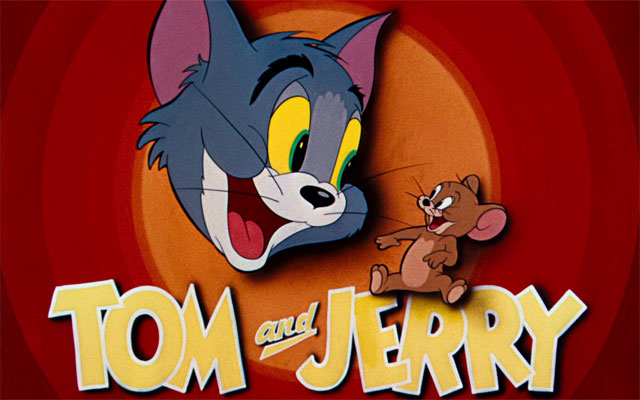They’ve won seven Oscars, enjoyed a billing as stars of the highest-grossing animated hits, and yet won’t stop unleashing mayhem over a slice of cheese. The legacy of Tom the cat and Jerry the mouse, favourite frenemy duo of toon lovers, perhaps lives on in their signature relish for mayhem more than their Oscar feats. Eighty-three years since William Hanna and Joseph Barbera launched the first Tom And Jerry animated short on February 10, 1940, the furry grey cat and the wily brown mouse have lost none of their mojo. Generations later, children still find reasons to laugh out loud in every frame. Older viewers, watching reruns that revive childhood memories, find resonance somewhere in the duo’s ditzy antics, of the struggle in life to have one’s cheese and eat it too.
For, the world of Tom and Jerry essentially nutshells the world we live in, where denizens strive to survive an unspoken pecking order. Puny Jerry’s fight, in most of the cartoons, is to outwit the burlier Tom, which makes their adventures a textbook lesson on how to be intrepid while facing a bully.
Yet, Tom the bully gets bullied, too. There is the matronly housekeeper Mammy Two-Shoes who quite obviously can’t stand the cat. In the later adventures, the cat’s owner is a cranky middle-aged man with a tendency to bash him up or, in a few cases, a stern white woman with an Irish twang. Outside the comfort of home, there’s Butch the cigar-chomping alley cat to contend with, who mostly beats Tom at courting the pretty neighbourhood feline Toodles Galore. Then there’s Spike the ever-angry bulldog, Tom’s nemesis who often inadvertently ends up as Jerry’s ally and looks for half an excuse to rough up the cat.
Mostly, though, Jerry has never needed the aid of Mammy or Spike when it comes to fixing Tom, in their capers ranging from shorts to feature films. The tone that the show has maintained— of an underdog outsmarting his stronger, albeit slower, tormentor — was set in the very first short that released in February 1940. Titled Puss Gets The Boots, the nine-minute and 16-second film is a laughathon about, you guessed it, clever Jerry besting Tom’s efforts to literally gobble him up.
Yet, Tom never really gobbles Jerry up even when he gets a clear chance, and that’s where the chaotic cat-mouse universe finds a context, and its key to sustain popularity over the decades. The larger picture drawn is of how bullies never really believe in demolishing the ones they torment and,beneath the mindless slapstick, almost every storyline cashes in on the oldest formula in the fiction book: The little guy will always find a way.
Jasper and Jinx —that’s what Hanna and Barbera named Tom and Jerry in the early years — managed to maintain that formula without falling prey to stereotyping through multiple change of hands. The original Hanna-Barbera phase lasted from 1940 to 1958, and saw 114 shorts produced for Metro-Goldwyn-Mayer (MGM). The first of the shorts, Puss Gets The Boot, opened in theatres on February 10, 1940, although the names Tom and Jerry would be decided only after its release through a contest. What followed was the phase that catapulted Tom and Jerry to iconic heights. By the time Puss Gets The Boot was nominated at the 1941 Oscars in the Best Short Subject: Cartoons category, Tom and Jerry were bona fide Hollywood stars. In all, their adventures of the Hanna-Barbera era would be nominated at the Oscars 13 times between 1941 and 1954, and fetch seven trophies.
By 1958, television was redefining American entertainment, and Hanna-Barbera quit MGM to create animated TV shows such as The Flintstones, Scooby-Doo and The Jetsons. Their cat-and mouse brainchild would change hands several times thereon. A brief tenure headed by illustrator Gene Deitch started in 1961after a hiatus following Hanna-Barbera’s exit.
Deitch’s era is significant because this was the first time deliberations arose over the violence quotient in Tom And Jerry. For decades, the hammering, head-crushing, falling, breaking of bones and bombastic explosions had been drawing criticism from those who felt such depiction in cartoons was unsuitable for children. The cut-down on the violence, however, would happen over a decade later. During Deitch’s time, majority of the audience felt the over-the-top action was too spoofy for serious impact. Despite the heavy violence there has never been a shot of bloodshed. Neither do Tom and Jerry ever die because, at the end of the day, they are cartoons and not humans.
Creatively, the Deitch era was one that survived tight budgeting, that forced toning down of backdrop art. This led to a few changes while packaging Tom and Jerry. First, Deitch amped the background score with loud sound effects to offset the spartan look. Secondly, in sync with the growing Hollywood trend of filming across the globe, Deitchimagined stories in locales ranging from Ancient Greece to the African wilds. This was an era of changing socio-politics, too, with Black housekeeper Mammy Two-Shoes and her African-American cliches raising protest. The humour took a blow, but Tom And Jerry ended up the highest-grossing animated short series of 1962.
The one thing that has never changed despite the creative and socio-political storms they faced is the spirit of mischief that drives fan frenzy around them. Each generation of creators has tried to interpret it in their own way. The Chuck Jones era that followed Deitch, from 1963 to 1967, focused on physical makeover. Jones gave Tom a longer tail and bushy eyebrows for a meaner impact. Jerry received bigger eyes and ears, besides a rounded face, for a more wicked edge. Of all the creators, Jones played with expressions the most. By 1975, Hanna-Barbera were back at helm, with a studio directive on toning down the violence. On cue, Tom and Jerry turned frenemies — friends who would occasionally and harmlessly bicker. The new releases, although politically correct, seem to lack the humorous spark of Hanna-Barbera’s earlier shorts. There have been many more change of hands for Tom and Jerry since then. The property is a signature brand of Warner Bros. since 2006.
Tom and Jerry, however, can never go away, if only because of the infinite possibilities that a cat chasing a mouse manages to evoke. It is a reason why despite the original show being long over, the duo has over the years found reinvention attempts through comicbooks, comic strips, gaming and even a musical titled Tom And Jerry: Purr-Chance To Dream. There have been a couple of feature films, too — a 1992 animated release and a live action-animation in 2021. Fans probably wouldn’t love talking about those misadventures.
(Puss Gets The Boot is available on YouTube)
Vinayak Chakravorty is a critic, columnist and film journalist.
Read all the Latest News , Trending News , Cricket News , Bollywood News , India News and Entertainment News here. Follow us on Facebook , Twitter and Instagram.


)




)
)
)
)
)
)
)
)